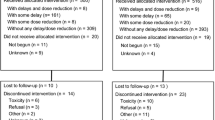Summary
Ifosfamide has definite efficacy in many malignant tumours, including breast cancer. In the present study we substituted cyclophosphamide with ifosfamide in the combination CMF (cyclophosphamide, methotrexate, and 5-fluorouracil) regimen in 25 patients with breast cancer whose disease was refractory to CMF or who had relapsed after previous response. Ifosfamide was given in an i.v. infusion at a dose of 1.2 g/m2 daily for 5 days, together with mesna as a uroprotector (at 20% of the ifosfamide dose). Methotrexate was given at a dose of 40 mg/m2 and 5-fluorouracil was given at 600 mg/m2, both by i.v. push. Courses were repeated every 21 days. The 24 evaluable patients received 3–12 courses (average, 5 courses); results included a complete remission in 3 patients (12.5%) and a partial remission in 3 (12.5%). Among the remaining patients, improvement was seen in 4 (16.6%); stable disease, in 7; and progressive disease, in 7 (29.2%). The complete responses lasted for 11+, 13+, and 15+ months, and partial remissions, for 2, 6, and 9 months. The responses were detected in soft-tissue as well as visceral lesions, but not in bony lesions. The responders remain under follow-up. This study shows the efficacy of ifosfamide-containing chemotherapy in breast cancer. As toxicities were tolerable, higher doses of ifosfamide could safely be used in these patients. Use of this combination as first-line therapy in breast cancer could be considered for a future study.
Similar content being viewed by others
References
Abelsberger B, Deicher H (1970) Suppression der Transplantations-Reaktion durch eine neue Stickstoff-Lost-Verbindung, 3-(2-chloräthyl)-2-(-2-chloräthylamino)-tetrahydro-2H-1,3,2, Oxazaphosphorine-2-Oxid. Arzneimittelforschung 20: 588
Hartwich G, Ehler R, Flügel H (1975) Zytostatische Kombinationsbehandlung mit Vincristin und Ifosfamid. Klinikarzt 9: 413–416
Hoefer-Janker H, Scheef W, Guenther U (1975) Erfahrungen mit der fraktionierten Ifosfamid Stosstherapie bei generalisierten malignen Tumoren. Med Welt 20: 972
Plotkin D, Waugh WJ (1983) Hypothesis: discontinuous chemotherapy for advanced breast cancer. Am J Clin Oncol 6: 375
Schnitker JN, Brock N, Burkert H, Fichtner E (1976) Ifosfamid bei malignen Tumoren. Arzneimittelforschung 26: 1783
Treske U (1977) Combination therapy of breast and ovarian carcinoma with Holoxan and tetrahydrofuryl-fluorouracil. Proceedings of Holoxan Symposium July 21–23, 1977, Asta-Werke, Düsseldorf, pp 170–177
Varini M (1987) Ifosfamide in tumour therapy. An overview. In: Ifosfamide in Tumor Therapy, Brade WP, Nagel GA, Seeber S, (eds) Contributions to Oncology, vol 26. Karger, Basel, p 12
Author information
Authors and Affiliations
Rights and permissions
About this article
Cite this article
Gad-El-Mawla, N., Hamza, M.R., Zikri, Z.K. et al. Ifosfamide, methotrexate, and 5-fluorouracil: effective combination in resistant breast cancer. Cancer Chemother. Pharmacol. 26 (Suppl 1), S85–S86 (1990). https://doi.org/10.1007/BF00685430
Issue Date:
DOI: https://doi.org/10.1007/BF00685430




